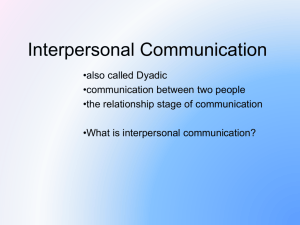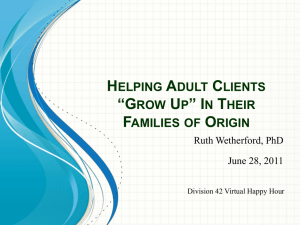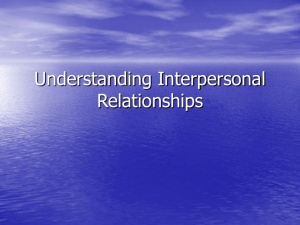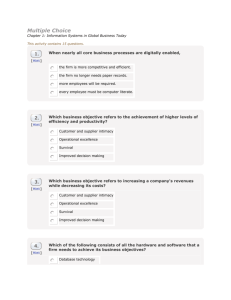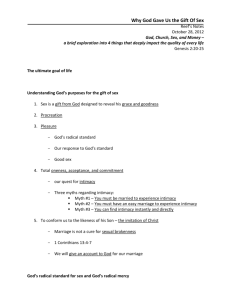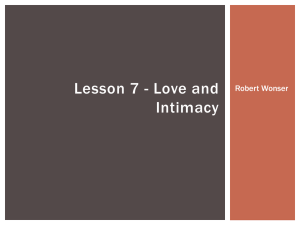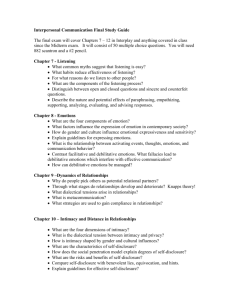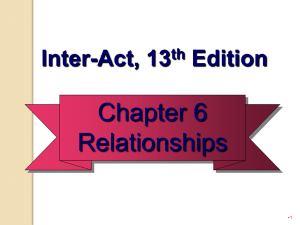ch9LookingOut - communication120
advertisement
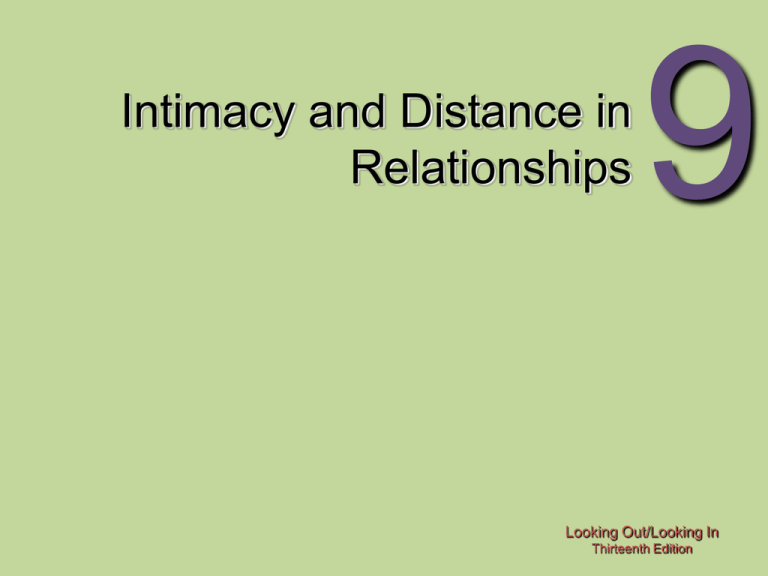
Intimacy and Distance in Relationships 9 Looking Out/Looking In Thirteenth Edition Intimacy in Relationships • What is Intimacy? • A state of “close union, contact, association, or acquaintance.” • When college students were asked to identify their “closest, deepest, most involved relationship” • 47% said their romantic partner • 36% said a close friend • 14% cited a family member INTIMACY AND DISTANCE IN RELATIONAL COMMUNICATION 2 Dimensions of Intimacy • Physical • Intellectual • Emotional • Shared Activities INTIMACY AND DISTANCE IN RELATIONAL COMMUNICATION 3 Masculine and Feminine Styles • Research shows that woman are somewhat more willing than men to share their feelings • In terms of amount and depth: • Female – Female were at the top • Male – Female came in second • Male – Male had the least disclosure • Generalizations do not apply to every person • Biological sex is not as important as the chosen gender role when expressing emotion INTIMACY AND DISTANCE IN RELATIONAL COMMUNICATION 4 Cultural Influences on Intimacy • Notions of public and private selves have changed over time • Collectivist cultures • Generally do not reach out to outsiders, often waiting until they are properly introduced before entering into conversation • Individualistic cultures • Make fewer distinctions between personal relationships and casual ones INTIMACY AND DISTANCE IN RELATIONAL COMMUNICATION 5 Intimacy in Mediated Communication • Studies show that intimacy may develop more quickly through mediated channels • Instant messaging, emailing and text messages offer more constant contact with friends, family and partners • Communicators chose varying levels of selfdisclosure INTIMACY AND DISTANCE IN RELATIONAL COMMUNICATION 6 The Limits of Intimacy • It is impossible to have a close relationship with everyone • Obsession with intimacy can lead to less satisfying relationships • Intimacy is rewarding but it isn’t the only way of relating to others INTIMACY AND DISTANCE IN RELATIONAL COMMUNICATION 7 Self-Disclosure in Relationships • Self-Disclosure • The process of deliberately revealing information about oneself that is significant and would not normally be known by others • Characteristics of Self-Disclosure • • • • Usually occurs in dyads Incremental Relatively scarce Best in context of positive relationships INTIMACY AND DISTANCE IN RELATIONAL COMMUNICATION 8 Self-Disclosure in Relationships • A Model of Self-Disclosure • Johari Window INTIMACY AND DISTANCE IN RELATIONAL COMMUNICATION 9 Benefits of Self-Disclosure • Catharsis (get it off your chest) • Self-Validation (get listeners approval) • Identity Management • Relationship Maintenance and Enhancement • Reciprocity (Self-disclosure often begets another) • Self-Clarification (clarify your beliefs, opinions…) • Social Influence (may increase control over other a situation, etc.) INTIMACY AND DISTANCE IN RELATIONAL COMMUNICATION 10 Risks of Self-Disclosure • Decrease in Relational Satisfaction • Loss of Influence • Hurting the Other Person • Rejection • Negative Impression INTIMACY AND DISTANCE IN RELATIONAL COMMUNICATION 11 Guidelines for Self-Disclosure • Do you have a moral obligation to disclose? • Is the other person important to you? • Are the amount and type of disclosures appropriate? • Is the risk of disclosing reasonable? • Is the disclosure relevant to the situation? • Will the effect be constructive? • Is the self-disclosure clear and understandable? • Is the self-disclosure reciprocated? INTIMACY AND DISTANCE IN RELATIONAL COMMUNICATION 12 Alternatives to Self-Disclosure • Silence • Lying • To save face, avoid tension or conflict, guide social interaction, expand or reduce relationships, gain power • Hinting • Equivocating - Language that has two or more equally plausible meanings • A lazy worker: “You will be lucky to get this person to work for you.” INTIMACY AND DISTANCE IN RELATIONAL COMMUNICATION 13
